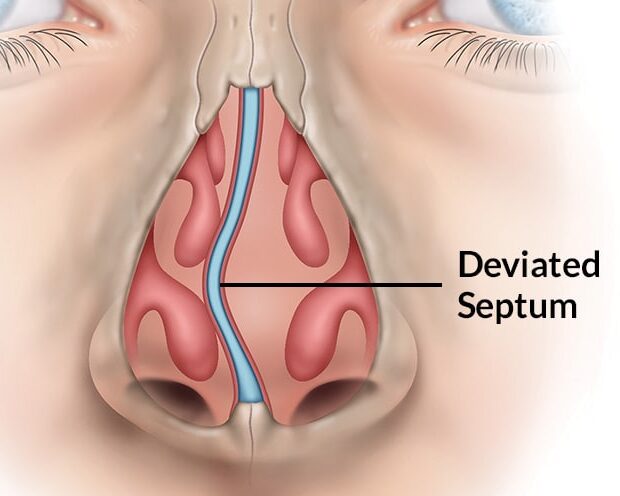WHAT IS NASAL SEPTUM?
The nasal septum is the anatomical structure inside the nose that separates the left and right nasal passages or nostrils. It is composed of both bone and cartilage and serves to provide structural support to the nose. The nasal septum plays a crucial role in regulating airflow and maintaining the shape of the nose.
WHAT IS DEVIATED NASAL SEPTUM?
A deviated nasal septum is a medical condition where the thin wall of cartilage and bone (nasal septum) that separates the two nostrils is displaced or deviated to one side, making one nasal passage smaller than the other. This condition can be congenital (present at birth) or develop later in life due to injury or trauma to the nose.
WHAT ARE SYMPTOMS OF DEVIATED NASAL SPETUM?
Nasal blockage/congestion: One side (commonly) or both sides (occasionally) of the nose may be blocked, making it difficult to breathe through that nostril. This is most common symptom of nasal blockage. All other symptoms are rare and mostly occur in combination
with nasal blockage,
Nosebleeds: Dryness and irritation of the nasal passages can lead to nosebleeds. Recurrent sinus infections:A deviated septum can disrupt the normal flow of mucus in the nasal passages, increasing the risk of sinus infections.
Loud breathing or snoring: The altered airflow through the nose can result in noisy breathing, especially during sleep.
HOW IS DEVIATED NASAL SPETUM DIAGNOSED?
A deviated nasal septum can often be diagnosed through a physical examination by an ear, nose, and throat (ENT) specialist. Sometimes, imaging tests like CT scans or nasal endoscopy may be used to get a better view of the nasal passages.
HOW IS DEVIATED NASAL SEPTUM TREATED?
Treatment for a deviated nasal septum depends on the severity of symptoms. Treatment options include:
Nasal decongestants: Over-the-counter or prescription medications can temporarily relieve nasal congestion.
Nasal corticosteroid sprays: These can help reduce inflammation and alleviate symptoms.
Septoplasty: This surgical procedure involves straightening the nasal septum. It is typically recommended for individuals with severe symptoms that do not respond to other treatments.
DO I NEED SURGERY?
Many patients with deviated nasal septum are asymptomatic. Some patient do develop symptoms and can be helped with surgery. Whether you would benefit from surgery should be assessed by an expert in this field which is commonly an ear nose throat specialist. Since this is a quality of life problem the decision to undergo surgery would usually be yours. Mr Sood recommends a shared decision-making and will help you by informing the risks and benefits of the surgery after taking into account your degree of nasal septum and the severity of your nasal symptoms.
WHEN CAN I GO HOME?
Most cases go home the same day. However this will also be dependent on your fitness of surgery and if you have lots of comorbidities or have an increased risk of bleeding you may require a stay in the hospital for a day or two.
CAN I GO TO WORK AFTER SURGERY?
Mr Sood as a routine recommends a couple of weeks off work after the surgery. This is to avoid any strain from work and to help you recover well.
WHAT SHOULD I EXPECT WHEN I GO HOME?
You would notice some drowsiness because of the anaesthesia. From nose point of you you will feel blocked because you may have dressings place inside your nose or because of expected swelling after the surgery. This is usually absorbable dressing and should dissolve on its own or sometimes comes out as a blob of red mucous or a clot. Do not be alarmed if that happens. You will be given some drops/ sprays after the surgery. Use them as explained at the time of discharge.
WHEN WILL I BE SEEN AGAIN?
You will be seen back in the clinic few weeks after the surgery
WHAT ARE THE RISKS OF SURGERY?
Bleeding: This is the most common symptom of any surgery. In case of nasal surgery the risk is relatively high because of the rich blood supply of nose. After the surgery you will notice some old blood or small amount of blood mixed with mucus coming out through your nose. This should not be heavy and is expected. In some cases excess bleeding can happen. If that happens you should return to your nearest emergency hospital where this can be controlled. The methods of controlling bleeding are pressure or placements of dressings inside the nose called nasal packs or nasal balloons. If extremely rare circumstances the bleeding can be heavy or if you loose too much blood before reaching the hospital you may require blood transfusion. If you have objections to blood transfusion please discuss with Mr Sood prior to Surgery.
Septal Haematoma: this means collection of blood or blood clots between the lining of a needle septum. This can cause pressure and compromise the blood supply to your nasal septum or can further get infected. In the unfortunate circumstance of this happening and additional small procedure to drain this blood clot under local or general anaesthesia may be required.
Hole in the nasal septum or septal perforation: this is a rare complication of septal surgery. If happens the air flow from one side of your nose to the other will become turbulent leading to further symptoms like nasal blockage, whistling sound, nose bleeds, crusting etc. If the symptoms become severe you may require another surgery to close this hole.
Further treatment: rarely the septum may not become straight or can you go back again to its deviated state after the surgery. If that happens and the symptoms start affecting quality of life , revision surgery may be required.
Change in the shape of the nose: this is extremely rare but some patients may notice a slight change in the shape of the nose after the surgery.
Numbness of the upper teeth or lips: This is usually temporary and settles over a period of time.


Leave a Reply